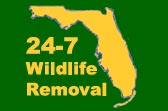|
|
|
| |
|
About Florida's Venomous Snakes - Identification & Bite Advice
Florida is home to 45 snake species, many of which may look dangerous to humans. However,
most are ultimately beneficial in the capture of rats and mice. Common non-venomous snake species
include the Black Racer, Corn Snake, Eastern Garter Snake, Eastern & Southern Hognose Snake, Yellow Rat Snake, Red Rat Snake,
Southern Black Snake, Rough Green Snake, and Southern Ringneck Snake.
If the below pictures aren't enough help, read my snake identification guide to tell the differences between a harmless snake and a dangerous one.
Florida is home to six kinds of venomous snakes. There are two types of venomous snakes in
Florida. The Crotalidae, or pit vipers, and the Elapidae. Included in the family of pit vipers are the
Diamondback Rattlesnake, Canebrake Rattlesnake, Pigmy Rattlesnake, Cottonmouth (or Water
Moccasin),
and the Copperhead. The venom of these snakes is haemotoxic, that is, it destroys the red blood cells
and the walls of the blood vessels of the victim. The Elapidae, represented in Florida by the Coral
Snake, have neurotoxic venom. This attacks the nervous system of a victim, bringing on paralysis. See
the pictures below to identify poisonous snakes of Florida.
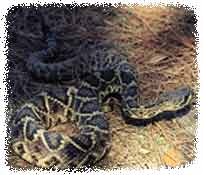 |
The Eastern Diamondback Rattlesnake is the largest and most dangerous of Florida's native
snakes. It also ranks high on the list of poisonous snakes of the world. Its large body size,
quantity of venom, aggressive defensive tactics and tremendous striking speed make this snake one
to be treated with extreme caution. Although it may attain a body length of over eight feet, it is
rare to find a rattler over seven feet long. Rattlesnakes feed on small warm-blooded animals, mainly
rabbits, squirrels, rats, mice, shrews, and occasionally birds. When disturbed, the rattler assumes a
defensive position with the body coiled upon itself, with the head and neck raised in an S-position.
From this stance, the rattler can deliver it's venomous strike. It almost always gives a warning rattle
of the tail first. The Easter Diamondback occurs in every Florida county and in many habitats. Average adult size is 36-72 inches, and the record is 96 inches. Click here for better photos and more info about Eastern Diamondback Rattlesnake
|
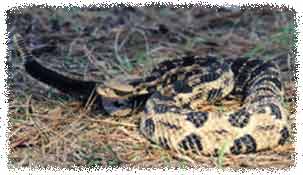 |
The Canebrake Rattlesnake, also called the Timber Rattlesnake, is restricted mainly to northern Florida but has been reported as far
south as Alchua County. This snake is the southern subspecies of the timber rattlesnake found in other
portions of the United States. As in other rattlesnakes, the head is much wider than the neck. It is
more slender in build than the average diamondback. Florida specimens seldom measure more than five
feet in length. Usually found in the flatwoods, river bottoms and hammocks, the canebrake also occurs
in abandoned fields and around farms. Average adult size is 36-60 inches, and the record is 74.5 inches. Click here for better photos
of the Timber Rattlesnake
|
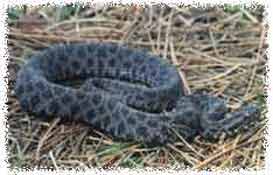 |
The Pygmy Rattlesnake, also called ground rattler, is common throughout Florida. It is found in
every county. Its rattle is small and slender and produces a sound like the buzzing of an insect, which
may be difficult to hear. Most pygmy rattlers measure less than 18 inches in length. It feeds on small
frogs, lizards, mice and other snakes. The Pygmy has a feisty disposition, and is quick to strike. Luckily,
it usually does not inject enough venom to kill an adult human. Average adult size is 12-24 inches, and the record is 31 inches. Click here for better photos and more info about Pygmy Rattlesnake
|
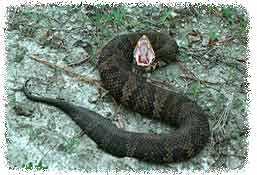 |
The Cottonmouth or Water Moccasin is a pit viper without rattles. It occurs
commonly in every county in the state. Often when disturbed it draws into a loose coil, cocks its head
upwards and opens its mouth wide to reveal the whitish interior lining, hence the name cottonmouth. It
does not have to be coiled to strike, but can deliver a bite from almost any position, either in or
out of the water. It is an unpredictable snake. Some individuals are calm and sluggish while others
may be very aggressive. A water snake, the cottonmouth is found along stream banks, in swamps, margins
of lakes and in tree-bordered marshes. It hunts at night for its prey of fish, frogs and other snakes,
lizards and small mammals. The poisonous bite of this reptile results in great pain and severe swelling. With
immediate and proper medical treatment, the bite is only occasionally fatal to humans. Average adult size is 20-48 inches, and the record is 74.5 inches. Click here for better photos and more info about Cottonmouth
|
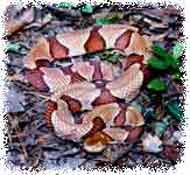 |
The Copperhead is rarely if ever identified in the Orlando area. Most Florida copperheads
are confined to the panhandle. Many snakes that are reported to be copperheads turn
out to be young cottonmouths which are similar in appearance. Or often, Brown or
Banded Water Snakes, which are also commonly mis-identified. The copper-colored head is wider than
the neck. Average adult size is 22-36 inches, and the record is 53 inches. Photo by Mike Monlezun. Click here for better photos
of mine and more info about Copperhead snakes. Also, in case you are confused, here is a great page
I've made showing the difference between the Copperhead vs Cottonmouth that includes many photos, maps of range, info on venom potency, etc.
|
 |
The Coral Snake's venom is the most potent of any of North America's snakes. It has short fangs
and a small mouth. It does not strike like the pit vipers but bites and chews to inject its poison.
Many people use this rhyme "red touch yellow, kill a fellow; red touch black, okay Jack." to differentiate
the Coral Snake from non-venomous copycats like the Scarlet King Snake. It occurs throughout Florida, primarily
in heavy brush. Average adult size is 20-30 inches, and the record is 47.5 inches. Click here for better photos and more info about Eastern Coral Snake
|
For more snake photos that I have taken over the years, including several venomous species, see my snake pictures page or click on the photos portion of any of my pages.
We also sell a special trap designed just for snakes. It is very effective, and placed outside works 24-7-365 to trap snakes alive, and it is re-usable. Use this
trap if you want to remove unwanted snakes from your property, or if you want to catch snakes for collection or observation. It works both inside the home or garage
or outside and has a proven track record of hundreds of snake captures.

 Click here to purchase our professional snake trap for $24.95 Click here to purchase our professional snake trap for $24.95

Florida Snakebite Advice
NOTE: If you find a snake and you do not know whether or not it is poisonous, the safest thing to do is to leave it
alone. If you or someone else is bitten by a poisonous snake, you should immediately seek medical attention at the nearest hospital or medical facility.
What to do if you are bitten by a venomous snake:
Opinions regarding snakebite treatment vary wildly. Some people propose extreme measures such as "apply a tourniquet above the bite, cut
the bite area with a razor and vigorously suck out the poison", while other offer simple advice such as "stay calm and contact a hospital". Here
is a list of what I believe are the best measures for snakebite:
- Stay calm, and don't jump to conclusions - perhaps it was a non-venomous snake.
- Try to stay still - exercise increases blood flow and venom spread.
- Apply a light elastic dressing such as an ACE bandage above the bite area.
- Some people suggest keeping the bite area below heart level to slow venom spread.
- Some people suggest the use of cold packs or ice to keep swelling down and slow venom spread.
- Most important: Contact your nearest medical facility. Anti-venom is often the only effective treatment
- It will help medical personnel if you can identify the snake. Use the above photos as a guide.
Remember, venomous snakebites are rare, and can be avoided with common sense:
- Do not handle or provoke snakes - leave them alone.
- Do not feel the need to take action against a snake - just back away.
- Beware of heavy brush and bare legs. Don't stick your hands into dark holes. Etc.
- If you positively ID venomous snakes in your area, maintain extra caution, and try to take preventive measures.
Florida Snake Prevention
Some people's property provides attractive habitat to snakes. These people may notice at one time or another, perhaps
frequently, snakes on the premises, or even in the home. Snakes require the same basic conditions that all living things
require, namely shelter and food sources. For snakes, shelter includes ground level debris and crevices. Snakes are cold
blooded, so they also like rocks upon which to bask (rocks gather heat). Snakes need only a small crack to enter an area,
an important fact to keep in mind when examining a home for entry points. I find many snakes inside homes with gaps under
doors. Here is a list of useful snake detterent methods:
- Eliminate debris such as wood or rock piles on the property.
- Cut down heavy brush or trim back hedges.
- Seal small gaps under doors or decks, etc.
- Use funnel type traps or glue board type traps along edges.
- An extreme remedy would be a perimeter wide fence sloping outward at a 30 degree angle.
The following remedies are suspect:
- Use of sisal rope around the property - the theory is that the course rope is tough on a snake's belly, but it's not true.
- Use of snake repellants such as sulphur, mothballs, or Snake-A-Way, a combination of the two.
- Use of predator scents such as mongoose urine or kingsnake musk.
- Use of ultrasonic sound emitters (snakes can't hear, at least in high frequencies).
- Use of fake owls or hawk decoys.

Click the above image for my David Seerveld's Photos of Florida Snakes gallery picture page.
|
|
|
